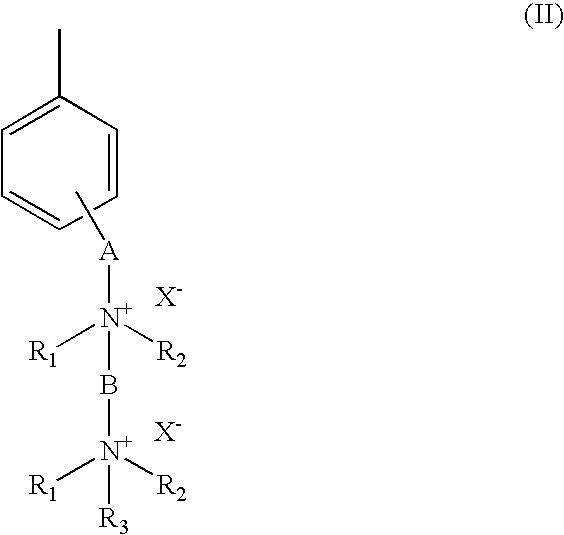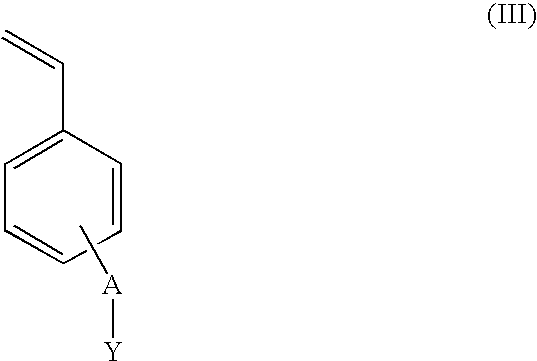Electrochemical devices containing anionic-exchange membranes and polymeric ionomers
- Summary
- Abstract
- Description
- Claims
- Application Information
AI Technical Summary
Benefits of technology
Problems solved by technology
Method used
Image
Examples
example 1
[0049]5 moles of p-chloro-methyl styrene (VBC), 1 mol of monomer units of block-copolymer SBS and 0.3% by weight (in respect of SBS) of benzoyl peroxide were mixed under inert atmosphere and stirred at 80° C. for 3 hours. The mixture was then diluted with chloroform and purified by repeated precipitations in methanol and / or acetone. 1 mol of monomeric units of the obtained polymer was dissolved in chloroform and filmed on Teflon by slow evaporation of the solvent in an atmosphere saturated with chloroform. The film obtained was then immersed into a 1,4-diazabicyclo[2.2.2]octane (Dabco) 1M methanol solution at 60° C. for 72 hours.
TABLE 1Grafting reaction between SBS and p-chloromethyl styrene (VBC)EntryBPO (% mol)1FD (% mol)2SBSF80.255.2SBSF100.303.7SBSF90.464.4SBSF110.606.4SBSF130.707.0SBSF141.1011.21with respect to 100 monomeric units of SBS2VBC grafting degree with respect to 100 monomeric units of SBS
example 2
[0050]The films prepared as reported in the example 1 was characterized by electrochemical resistance and impedence measurements in bidistilled water or in KOH 1, 5 and 10 wt. % solutions respectively. The results are reported in Table 2 and 3 and compared with the values obtained in the same conditions for a benchmark membrane by Fumatech GmbH (Germany).
TABLE 2Electric resistance (in Ω) of anionic-exchange membranes(film thickness 60 μm)SampleH2O ddKOH 1%KOH 5%KOH 10%SBSF80.210.120.0860.067SBSF90.320.150.110.086SBSF140.250.180.140.10FAA (Fumatech)0.360.270.190.15
TABLE 3Conductivity values (in S / cm) of the prepared anionic-exchangemembranes (film thickness 60 μm)SampleH2O ddKOH 1%KOH 5%KOH 10%SBSF80.0280.0500.0690.089SBSF90.0180.0400.0540.069SBSF140.0160.0220.0290.040FAA (Fumatech)0.0190.0260.0370.047
example 3
[0051]The thermal stability of the prepared membranes was evaluated by differential scanning calorimetry (DSC). The polymer film SBSF9 was analysed before and after immersion into a water solution containing the 5% of KOH and the 10% of ethanol for 1 hour at 80° C. The solution is an example of fuel potentially employed in direct alcohol fuel cells. In addition a thermal-degradation analysis under nitrogen atmosphere was performed in order to evaluate the thermal stability interval of the membranes. All the data were reported in table 4.
TABLE 4Glass transition temperature (Tg, ° C.) and thermal degradationtemperature (Td, onset, ° C.) of SBSF9Before treatment (° C.)After treatment (° C.)Tg1−92−92Tg27267Td1244235Td2411408
[0052]The glass transition and degradation temperatures before and after thermal treatment in strong alkaline solution appeared similar in values indicating that neither the structure of the polymer backbone nor the reticulation degree, obtained with DABCO, were affe...
PUM
| Property | Measurement | Unit |
|---|---|---|
| Temperature | aaaaa | aaaaa |
| Temperature | aaaaa | aaaaa |
| Temperature | aaaaa | aaaaa |
Abstract
Description
Claims
Application Information
 Login to View More
Login to View More - R&D
- Intellectual Property
- Life Sciences
- Materials
- Tech Scout
- Unparalleled Data Quality
- Higher Quality Content
- 60% Fewer Hallucinations
Browse by: Latest US Patents, China's latest patents, Technical Efficacy Thesaurus, Application Domain, Technology Topic, Popular Technical Reports.
© 2025 PatSnap. All rights reserved.Legal|Privacy policy|Modern Slavery Act Transparency Statement|Sitemap|About US| Contact US: help@patsnap.com



